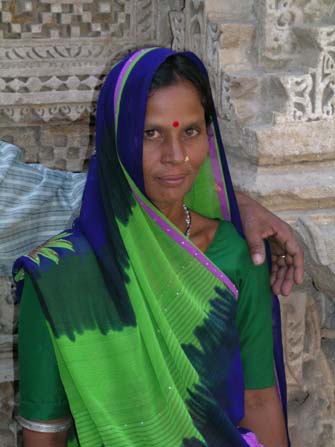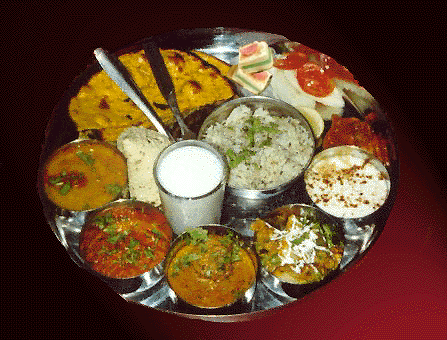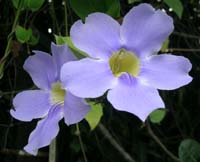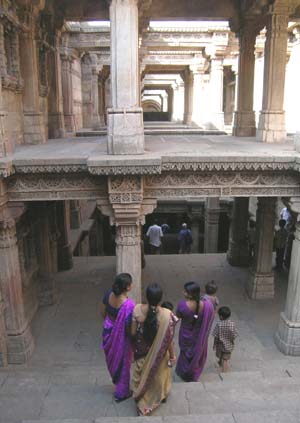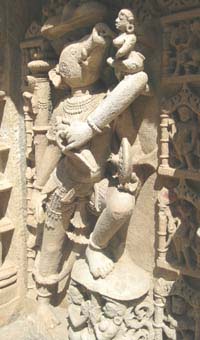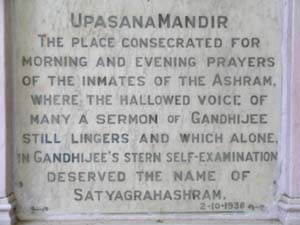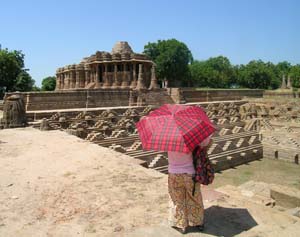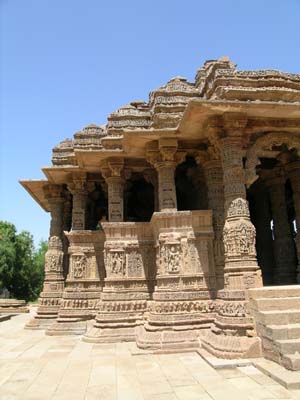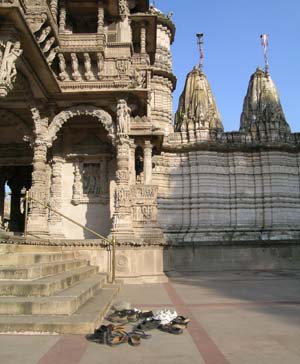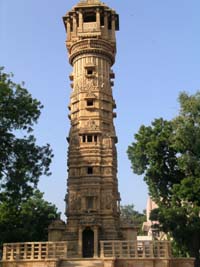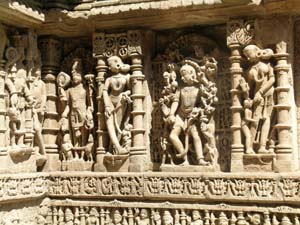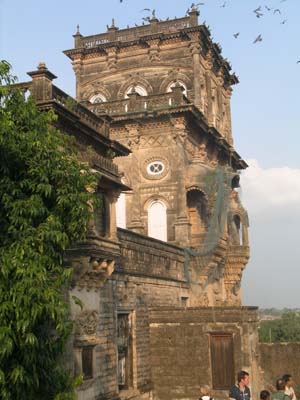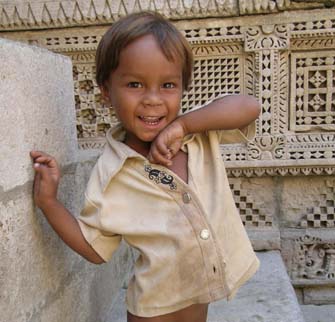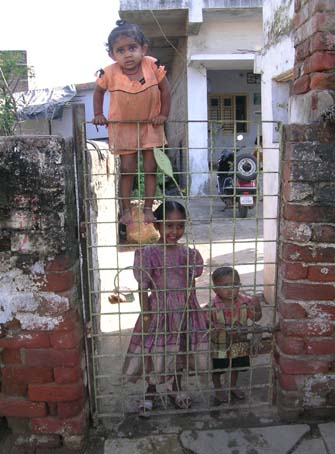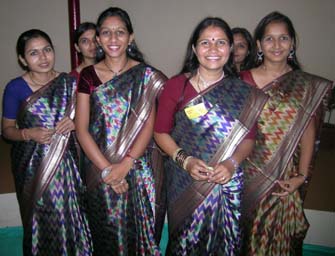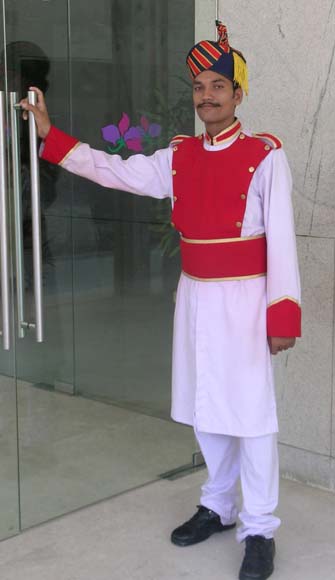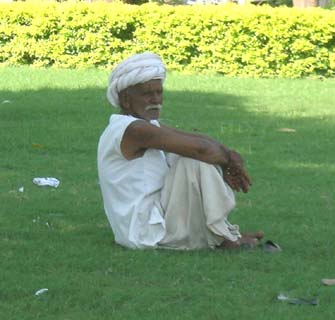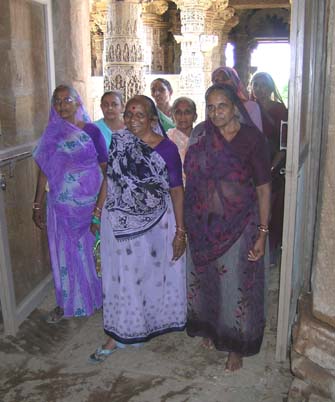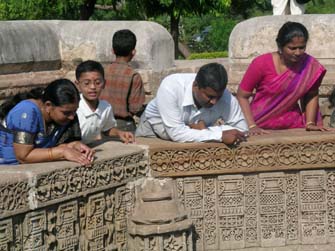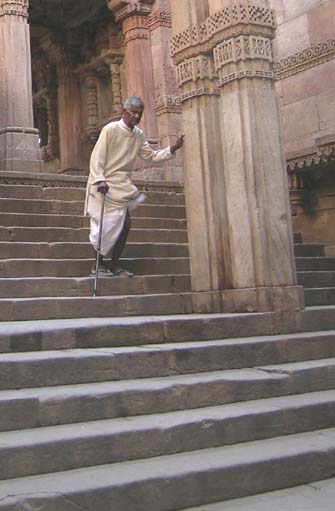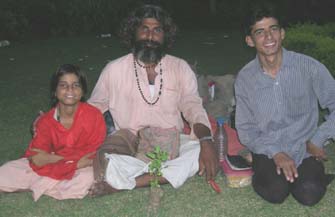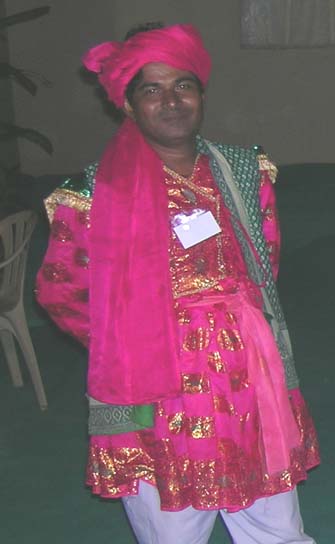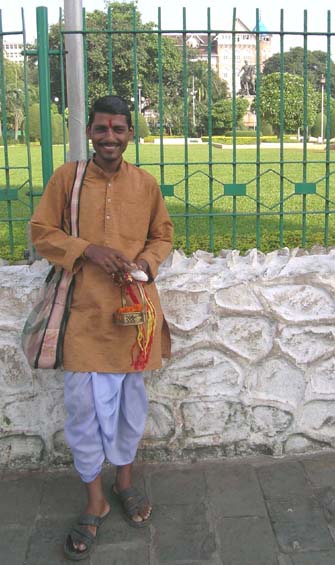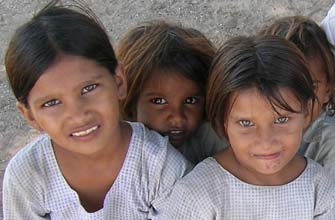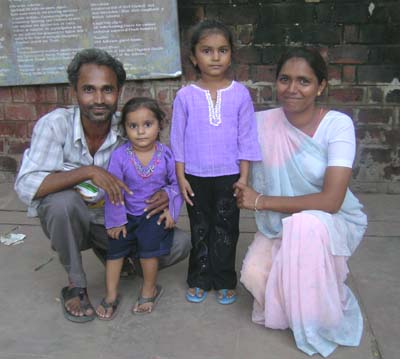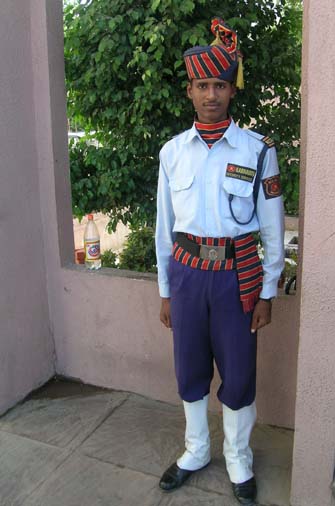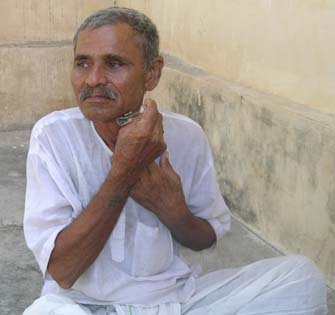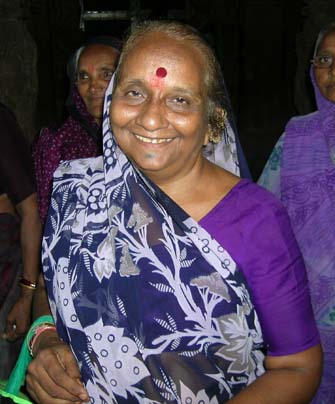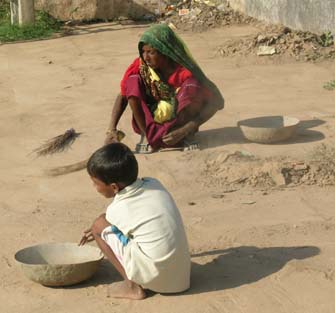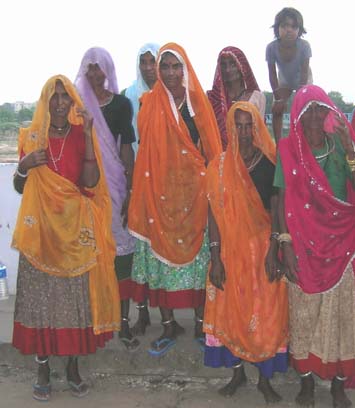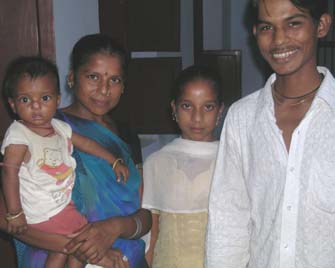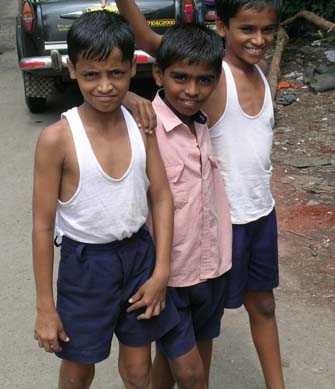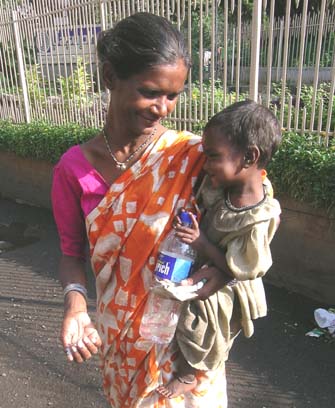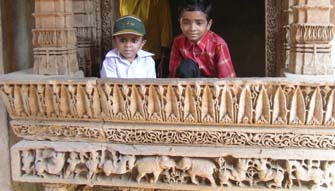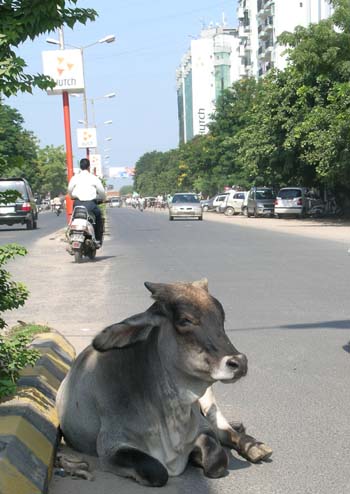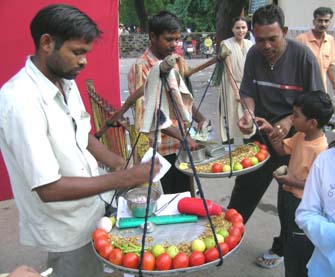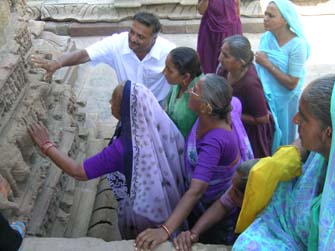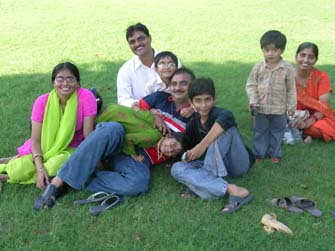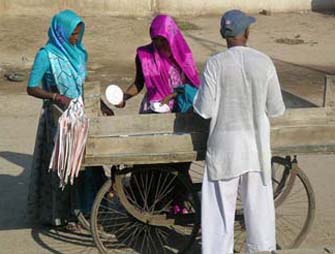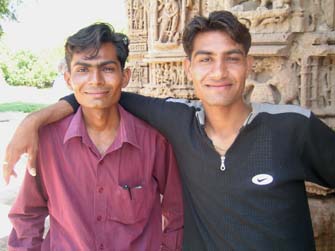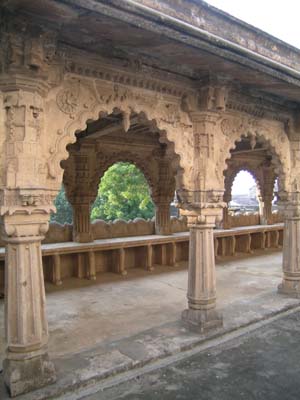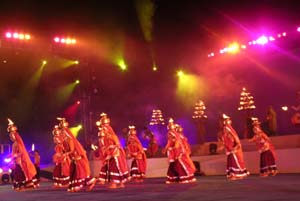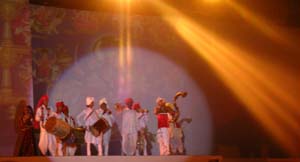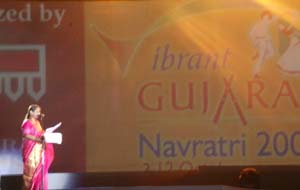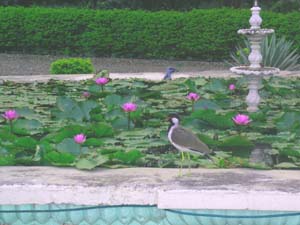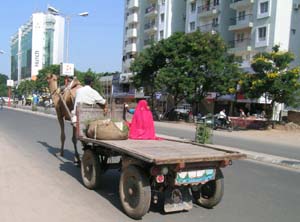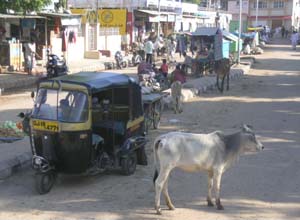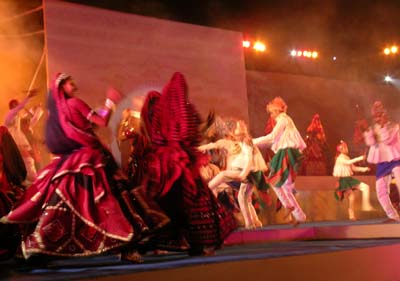|
|
The
Faces of Gujarat: As she descends the stone steps leading to the small dark pool at the core of the exquisite Adalaj Step Well, her sari floats freely around her delicate frame. Her gracefulness and sylphlike steps give the impression that she is being borne downwards on a whisper of moist air. Her son, a sprite of a boy, precedes her slightly. Barefoot and naked, except for a loose cotton shirt enhanced by a single hand stitched design, he slips carefully and silently from one step to the next. Close behind follows the tall and loose-limbed father performing analogous movements. Together, the three of them have the weightlessness and beauty of an apparition; astonishing in their elegance. It is another moment in which I realize how much of India is perceived through the mind's eye. |
|||||
As the family of three descend towards what is left of the well water, they pause on a wide landing illuminated by the sun, which has worked its way through the complex architecture of the structure. Seeing an opportunity too good to be missed, I hesitantly approach and ask if I may photograph them. Anticipating a possible rebuff — at such times I always feel like a lumpish tourist — I am instead met with a beaming smile and a welcome invitation on the part of the father to admire his wife and son, and to record the moment. My Western mind hesitates briefly, considering what in my culture would likely appear as a paternalistic gesture on his part. But, as has been the case with other individuals and families on this trip, there is a genuine expression of appreciation for the attention — a suggestion of a validation of their existence — and a desire for a cultural interchange. I prepare to photograph the mother. She stands against one of the intricately carved walls in a somewhat posed position, eyes downcast, and demure. I lower the camera and glance at the husband. He smiles again and gently lays his arm around his wife's shoulders. At his touch, she suddenly looks up, her sari falls back slightly off her face. I see an amazing radiance and openness of expression; and I realize that this is a privileged moment. I raise the camera and quickly capture what will become the principal focal point and theme of my visit to Gujarat — the faces of the Gujarati people.
A Gujarati Thali
Borrowing the adage, “you are what you eat,” and then extending that metaphor, the festive, ceremonial, and vegetarian Gujarati Thali cuisine can also be seen as representing this complex culture which is part of the larger (1.3 billion population) Indian culture. The Thali is exotica and diversity writ large. It is also the product of the millennia. To the Western palate it is a whole new culinary experience: farsans (delicate appetizers), sweet and sour chutneys, pickles, sweetmeats, vegetables of all kinds prepared with aromatic seasonings, Bhaat (rice), lentils, bean sprouts, butter milk, nuts, roti or poori (special flat breads), Batata nu shaak (a potato dish in a sauce), and a yoghurt dessert that is flavoured with saffron and fruit.
Gujarati history and culture is also a kind of Thali of human experience. Coming from the recent “New World,” I learn quickly to adjust my sense of time; and I'm not just talking about jet lag. In terms of human civilization this is one of the oldest neighbourhoods on the planet. There is considerable archeological evidence that the area known today as Gujarat was part of the Indus Valley Civilization, one of the world' s oldest (3300 BCE until it mysteriously “disappeared”around 1700 BCE, give or take a couple of large chunks of time), and a contemporary of the Bronze Age civilizations of Mesopotamia and Ancient Egypt. It was known as the Harappan Civilization, named after the city of Harappa which was located in what today is Pakistan. This highly developed civilization was known for its organization and unified government; mainly urban and market-oriented. Gujarat is part of one of the most ancient trade routes on the planet. This was the part of the world that saw the first farming cultures and the emergence of human civilization. In Gujarat, the eons-old evidence of highly developed language, arts and architecture are all about, but not in the same highly structured way in which they are preserved in, for example, European destinations. Here you get a much greater sense of just happening upon ancient treasures as opposed to being strategically introduced to them. Part of the fascinating history of Gujarat also includes ancient empires (Maha, Mauryan, Gupta, Chola), sultanates, various subsequent eras, empires, the often highly romanticized British Raj — and the eventual Republic of India, which won Indians “freedom at midnight” on August 15th, 1947. The state is also (post-Independence) made up of many of the former princely states that once ruled India collectively, and the rich and regal residue can still be seen here. All these layers of history are woven into the brilliant fabric of Gujarat.
Like the larger nation of India, Gujarat is a diverse and multi-ethnic state, although primarily Hindu today. Gujaratis have a long history and tradition of hospitality, welcoming for example Parsi (Zoroastrian) refugees from Iran in 775 AD. Like the culinary harmony of Thali, Gujarat is known for its ethnic tolerance, despite a serious and politically contentious incident of violence between Hindus and Muslims that at the time gave the world a different view. Gujaratis also have a reputation as entrepreneurs and the state has been the point of emigration for many successful new citizens of the Americas and the United Kingdom. The Gujarati people are leaders in arts and sciences — you will even find a space program here. The 1600 kilometres of coastline of Gujarat and its strategic position on the Arabian Sea have contributed to its being a major trade route and global meeting place for millennia. In terms of agricultural products, think peanuts, cotton, dates, sugarcane, and the largest producer of milk and milk products in India. Oh ... and diamonds. Of the colonizing powers, Portugal arrived first and close on that country's heels was the British East India Company. Needless to say, it is a part of India that has spawned a great deal of historical writing — travel writing in the most comprehensive sense of the word. Gujarat has also contributed universal ideals and social principles to the world through its native-born charismatic leaders and their defining independence movement. Three of the most prominent came from Gujarat: Saradar Vallabhbhai Patel (the Iron Man of India), Morarji Desai (the first non-Congress party Prime Minister of India) — and the most illustrious of all, Mahatma Gandhi. The Adalaj Step Well
Approximately 20 kilometres north of Ahmedabad is one of the most curious and splendid archeological treasures in the ancient world — the Adalaj Vav Step Well. Step Wells (Vavs) are fairly common throughout Gujarat although most of them disappeared with the passage of time through lack of maintenance when other means of procuring water in this semi-arid countryside became available. Some however have been beautifully maintained as monuments to the early scientific and engineering skills of those who constructed them. A step well is, as it sounds, a deep well around which are built elaborate structures with wide, multi-stepped stairways that lead down to the water table and away from the oppressive sun that despite its intensity barely penetrates the protective stonework built over and around the pool. They were of course a major source of water — hence life — and to that extent they have an air of the sacred to them, although they are not temples. They were instead utilitarian public resources which were also highly ornamented with religious carvings. Every pillar and wall in the Adalaj Step Well is decorated with intricate carvings, many of which reflect the abundance of life (plants, flowers, fish, flowers) that would not be possible without the essential resource of water. A common marketing term used by the Gujarat Tourism Department is “Serene, Pristine, and Divine”; a trinity of descriptors that aptly sums up the Adalaj Step Well. Because the long western coastline of Gujarat made it the point of departure for an ancient caravan route along which the fabled riches of the East were transported, step wells were built along the way as rest stops and sanctuaries from the oppressive heat of the day. Caravans travelled by night and stopped at the step wells during the hottest part of the day, transforming them into early “multi-national” community centres — cool and peaceful oases. And this is the sense that you still get at the Adalaj Step Well. For a diagram and other images of Adalaj click here.
Ghandi's Ashram We visit Gandhi's ashram beside the Sabarmati River on his birthday,
and find ourselves in the midst of a quiet family celebration. But
it is a family celebration in a true “Gandhi” sense. As
one writer has described life in the ashram, it was “a haven
from the dust and din of the world. It was a family linked not by
blood or property, but by allegiance to common ideals.”
Visiting the ashram and visualizing the life and work that went on here, it is very easy to get a sense of who this man really was. The artifacts, photographs, and the peaceful setting evoke Mohandas Karamchand Gandhi, or as the world came to refer respectfully to him — Mahatma (Soulful One) Gandhi.
The Sun Temple of Modhera
Aligned on and east-west axis, this stunning temple exemplifies the millennia-old tradition of sun worship, but is unique to India. When you come upon the temple on the bank of the river Pushpavati, it is difficult initially to take it all in. Once again, you become aware of how much there is to be discovered in Gujarat; how much has not become a part of the global tourist route. If this were on most other travel itineraries, it would be swarming with busloads of tourists. But the Modhera Sun Temple remains a wide open space and at the same time a temple with a rare kind of intimacy and privacy. This intimacy is especially reflected in the intricately carved golden stonework; the whole temple is a sculpture in itself, a model of geometrical design and an elaborate three-dimensional representation of Hinduism. This is the kind of archeological and cultural treasure that deserves to be visited at leisure and in an unstructured way. As you meander in, out, and through the temple, you will see an exquisite pillared portico, a shrine with its resident deity that is also a refuge for the devoted, an assembly hall that is connected to the rest of the temple by a narrow passage, and most of all you will see an abundance of mythological figures and narrative. Amongst others, the temple is an archive of images of the deities from the Hindu pantheon, and a representation of Mount Meru where the gods resided. The temple, built during the Solanka era in 1026, is also an example of survival; having witnessed struggles between competing rulers over the centuries. Lord Rana is also believed to have performed a sacrifice here as penance for having killed a Brahmin. As a pilgrimage site, the Modhera Sun Temple is a universal representation of our innate recognition of our dependence on the sun around which all life on this planet revolves. At the time of the equinoxes, the sun's rays penetrate the temple and fall on the image of the sun god Surya.
The Hatheesing Jain Temple
Built in 1850 by a wealthy Jain merchant just outside the Delhi Gate in Ahmedabad, the Hatheesing Jain Temple is an intricate white marble structure that is one of the best examples of Indian architecture that demonstrates clearly the concept that the whole is the sum of the parts, a theme very appropriate to Gujarat, especially in religious matters. A visit to Gujarat is like a course in comparative religions. For those who come from a European Judaic-Christian cultural heritage, it is a direct-to-source opportunity not only to learn about other world religions like Hinduism, Jainism, and Islam; but it is also an opportunity to absorb visually and aesthetically the precepts of these faith systems. The relatively undiscovered architectural and aesthetic legacies and treasures of Islam, Jainism, Zoroastrianism, Christianity, and Hinduism are at the heart of this emerging travel destination. This is the land of Lord Krishna, the eighth avatar (a deity descended to earth in human form) of Vishnu — the supreme being. His story is one that resonates easily; a young boy of royal birth, living a pastoral life, who eventually becomes an heroic warrior who triumphs over evil — and also becomes a respected teacher. Some Hindu philosophers have emphasized that one of the interpretations of his name is “union of existence and bliss.”
One of Krishna's wives is Lakshmi. As the Mother of the Universe and goddess of wealth, light, fortune, beauty, and fertility, she is actually married to Vishnu and by extension Krishna.The Mother-Goddess personification will be a central theme of the trip, especially when we become caught up in the dazzling Navratri celebrations. Hers is also an ancient story that highlights her purity and divinity, and the goddess who is invoked in matters relating to happiness, family, friends, marriage, children, and the essentials of nourishment. Associated with the lotus, the exquisite flower that is born of the rich mud of dark waters, she symbolizes perfection and a transcendence of the material world. She is the embodiment of the nurturing female.
The Nauakha and Orchard Palaces
In Gondal, a fortified town about 300 kilometres from Ahmedabad, you will find palaces and a bygone lifestyle that could serve as a film set for the kind of romantic period piece about India and the British Raj that Westerners especially are drawn to. This set however is the real thing; a princely state over which ruled the Jadeja Rajputs who claim direct descent from Lord Krishna himself. The buildings that are currently under development as part of the emerging tourism market of Gujarat, include palaces turned heritage hotels and a palace-fort that evoke the reign of Maharajas. Here you will also see ghost-like remnants of a colonial period in India: photographs, period furniture, and unique architecture that, in some senses, seem to have been almost casually set aside, but not totally forgotten. The imposing Naulakha Palace for example, was built around 1748 AD on the riverbank and is an elaborate stone structure that incorporates various styles of architecture that are a blend of centuries past. The intricately carved arches of the courtyard are splendid. The private museum inside is at present rather undeveloped — from a tourist's point of view — but a fascinating and priceless collection of memorabilia from the time of the Maharaja Bhagwat Sinhji. Evocative would be an understatement. The Orchard Palace is equally evocative and has a slightly down-at-the heels look to it that actually contributes to its authenticity. Part of the estate of the former royal family of Gondal, the palace and grounds are noteworthy for their art deco furniture and antiques. And an especially curious archive on the grounds is an automobile fanatic's dream collection of vintage and classic cars owned by the rulers of Gondal. The town is a striking example of the influence of the British Empire on India and the problematic alliance between two very different sets of rulers. |
|
|||||
|
The Somnath Temple The Somnath Temple, the “Shrine Eternal,” seems a bit of an anachronism compared to the other treasures we had been seeing given that its most recent incarnation occurred in 1950. The current lofty, and in my view a bit bombastic, structure is the seventh such temple built on this spot to the glory of Lord Somnath. Legend has it that the moon god Soma built the original temple out of gold. That one was replaced by a temple of silver built by Ravan. Krishna later built one of wood, and finally King Bhimdev of Anhilwad built his of stone. Soma constructed the original temple in thanks to Lord Shiva who cured him of an illness — well actually a curse placed on him by his father-in-law who was perturbed that the King was spending all his time with only one of his 26 wives; the only one that was not the daughter of Daksha. The evening of our visit, there was a sound a light show happening at the temple, for which we arrived too late, but wandering behind the scenes while amplified celestial voices and creative lighting seemed to be happening in some other space, was a welcome departure from the group scene and an opportunity to feel a bit of privacy in the semi-darkness of the temple.
The Navratri Festival It makes your head spin. This event, touted as the world's longest dance festival, is certainly the biggest party I've ever been at. And the most colourful, the most vibrant, the most engaging. Navratri is also Gujarat itself: you cannot separate the two. It is a cultural event that is all about mood, aura, and charisma. Navratri (literally “nine nights”) is an ancient festival that celebrates the mother goddess in all her nine manifestations. It is also a festival that binds the diverse communities across the state in joyous revelry. And it was the principal reason we were here; our common journalistic cause. Whether it was at the enormous outdoor inaugural gala in Ahmedabad (with dignitaries, what seemed like a substantial representation of the 50 million Gujaratis in attendance, or a smattering of dazed Westerners) or whether it was at the local street celebrations, we were privileged to experience the heart and soul of Gujarat. And we danced too. Welcomed as special guests, we were called up on a small stage somewhere in the midst of endless Gujarat, and we joined in the festivities — rather awkwardly at first .But slowly we picked up the rhythms of Gujarat and became part of the nine nights. The Navratri celebrations were everywhere and they seemed to be happening all at once. Time and space merged. I even experience the festival during my last few nights in India. In the pulsating downtown area of Mumbai, one street is taken over by great crowds of people dancing and celebrating life in the name of the goddess who symbolizes the triumph of knowledge over ignorance and goodness over evil. And even as I leave my hotel near the airport to catch a late evening flight, my drivers have to wind their way through the back streets of the poorest part of Mumbai (the “slums” where I first experienced India) because the main road to the airport is closed for the celebrations. We drive a twisting, circuitous route through the pulsating spirit of Navratri, surrounded by laughing faces.
Travelling in Gujarat For passionate Indiaphiles, a very special breed of traveler, Gujarat has many treasures and distinct regional experiences. If this is your first time to India, as it was for me, I would recommend a tour. I would also recommend that you practise thinking in a lateral, as opposed to a linear, fashion because that is the kind travel you will be experiencing. The websites below will help in this respect.
|
||||||
